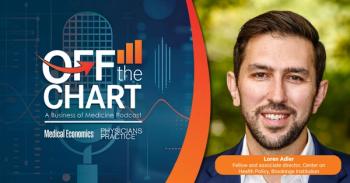
The Rising Cost of Patient Care
Physicians are becoming increasingly alarmed about the meteoric rise in costs to provide healthcare to their patients. Physician Practice's 2016 Great American Physician (GAP) Survey found that one-fifth of the 1,314 physician respondents say rising deductibles and cost sharing represent the largest barrier to good healthcare for their patients.
Pediatrician Terence McAllister and his spouse Leann DiDomenico McAllister, co-owner and practice administrator for their Plymouth, Mass.-based micropractice, Performance Pediatrics, say their practice and patients have been feeling the ill effects of a state decision to reel back reimbursement rates for the poorest patients.
"For patients on state assistance, the impact is in our community. Those patients are having a hard time finding any providers at all. Because even though they once had commercial primary [insurance] with the state secondary to cover their copays, now if the state is covering their deductibles, in Massachusetts the state only pays us 68 cents on the Medicare dollar [for Medicaid patients]. It is a very low amount, lower than a number of states similar in size to Massachusetts and [with] similar politics. So a lot of docs, including us, are just not taking those patients anymore," DiDomenico says.
Complicating the financial picture, third-party payers are moving en masse to insurance products with higher deductibles, placing greater financial burdens on both medical practices and their patients. What can physicians do to navigate this trend and help their patients better access care? We talked to the experts in the field to find out. Here's what they said.
*Be on the lookout for the Great American Physician Survey report, with
BARRIERS TO PATIENT CARE
Cost has assumed a key spot in discussions revolving around healthcare reform. It is top of mind for physicians as they struggle to contend with problems created by higher patient deductibles and rising drug costs. Here are three key factors that are driving up costs:
• Payer initiatives. Travis Broome is a healthcare economist who spent the first part of his career at CMS leading the development of Meaningful Use measures. Now he is healthcare policy lead at Aledade, Inc., a Bethesda, Md.-based firm that helps small, independent practices form Accountable Care Organizations (ACOs). He says that the motivation for establishing Aledade was to give physicians the collective power to manage outside demands such as strict payer requirements, growing patient cost sharing, and government programs that aim to steer physicians toward value-based care.
"The ACO is an organization that can contract with Medicare - that can contract with [Blue Cross Blue Shield] - to get the claims data flowing to [physicians], to know what the payer knows. And also to create the financial model for making the investments in care coordination, care management, population health … We get someone in their practice to help [physicians] translate what they see in the population health platform [to] what they should do differently," says Broome.
• High-deductible health plans. While there isn't a single cause that has contributed to the sharp rise in healthcare costs, the advent of high-deductible health plans (HDHPs) seems to have accelerated the process and ratcheted up the problem for physicians and their patients. It puts practices in an uncomfortable position: needing to collect outstanding patient balances more aggressively, while trying to sympathize with cash-strapped patients. It is a no-win situation, often forcing the staff to take on the role of "bad guy."
HDHPs were ostensibly created as a way to rein in runaway health costs, but they are increasingly becoming a problem for patients. Because of large annual deductibles which can range from hundreds of dollars to more than $5,000, these plans are also limiting patient access to healthcare - a fact confirmed by our survey respondents, 40 percent of whom said higher deductibles and higher patient cost-sharing were the largest barriers to good patient care in their practices.
Laurie Morgan, a partner with San Francisco-based consulting firm Capko & Morgan, says over the last decade the percentage of patients with HDHPs have exploded, citing statistics from the
• Prescription drug prices. In the 2016 release of the International Federation of Health Plans Comparative Price Report, which compares the global prices of healthcare and prescription medications across different countries, the United States stands out as the worst bargain, by far. For example, in the U.S., the arthritis drug Humira costs $2,669, yet in Switzerland the same drug costs only $822.
Most recently, a rising number of pharmaceutical companies have made exorbitant price increases for commonly prescribed medications. Mylan Pharmaceutical's drug EpiPen is one such example. The drug, which is used to treat anaphylactic shock in children and adults has undergone a six-fold increase over the last eight years - from $100 for a single injector to approximately $600. This puts many parents in an unthinkable position: choosing cost over protecting their child's life. Terence McAllister says he has witnessed his patients' families struggle, sometimes choosing to purchase only a single pen, rather than carry backups. For his own emergency response kit, McAllister now uses epinephrine and a syringe, rather than an EpiPen. "EpiPens expire in a year," he notes, "and it doesn't make sense to buy a new EpiPen every year when the cost of epinephrine is a fraction, a tenth or less of what it would cost me to buy an EpiPen. So those few extra seconds it would take me to draw up the epinephrine is something I have to account for."
THE EFFECTS OF HIGHER COSTS
When the cost of care is too high, patients are more likely to avoid visits to their doctor or skip needed testing, like blood work to check for diabetes. According to the American Academy of Pediatrics (AAP)
That has been Terrence McAllister's experience. "We certainly have seen a decrease in the amount of use that people are making of acute care. We've noticed that people, especially those with [HDHPs] are more likely to put off routine care for chronic problems like asthma or Attention Deficit Hyperactivity Disorder, or not to seek care promptly for more acute problems," he says.
Another result of the high cost of care is the intentional "rationing of care" by physicians who strive to order fewer tests or prescribe lower cost medications to help patients manage their healthcare costs. A survey published in the
TAKING BACK CONTROL
While physicians may feel hamstrung by outside forces and the high cost of care, there are concrete things they can do to take back control of their practices. Here are five strategies to consider:
• Educate patients and staff. The burden of high healthcare costs can touch both low- and high-income patients, says Morgan. It is embarrassing to be asked for an unexpected, large sum of money regardless of social strata. Some practices feel they shouldn't be responsible for educating patients about health insurance and their financial obligations. However, as Morgan points out, someone must do it. And since practices are essentially the endpoint in the revenue cycle and must often collect greater sums from patients, it is to their benefit to embrace both staff and patient education, so that there can be better communication on financial responsibilities.
• Use technology to assist in patient collections. One of the more effective strategies to assist in collections, says Morgan, is the use of technology. Using payer websites to verify patient eligibility and insurance benefits in real-time gives staff members valid information that they can share with patients, so that they may have respectful financial discussions about cost sharing. There are also a number of technology systems (patient portals and tablets) that can be used to facilitate ease of payments, and in some cases set up payment plans.
• Review payer contracts. While many practices let their payer contracts sit neglected in a desk drawer, this is the worst thing they can do. Many contracts contain an evergreen clause which lets them roll over at current reimbursement rates if the practice does nothing, says Morgan, meaning physicians can lose out on potential rate increases. It is better, she says, to hire outside help, if necessary, to manage payer contracts. The cost may be more than offset by negotiating more favorable terms at the end of the contract.
• Offer patients cash discounts. Because patients are more often faced with large deductibles that must be paid out of pocket, practices may come out better by offering cash discounts. The benefit to the practice is that they receive payment upfront in cash, and to the patient, a reduced financial responsibility. There is even a benefit to the insurance company, as payments that are accepted in cash are not applied to a patient's annual deductible. Morgan says practices must first review their payer contracts to make sure that this would not be in violation of a payer's "All Nations Clause," which would require that the practice charge the same fee for its services to all parties, patient and payer alike. If the terms of the payer contract allow for a cash discount, then this option is open to the practice. Morgan says it is always wise to contact the payer for guidance, first.
• Join a larger group. Becoming part of an ACO, independent physician association, or other large group can help small independent practices reap economies of scale, and provide better care to their patients through care coordination. The benefits to physicians include retaining their independence, access to powerful health information technology; participating in population health initiatives; and gaining negotiating clout with payers.
"In the shared savings programs and the ACOs, not only do you do [population health] because it's good for your patients, but so many physicians over time have essentially been trying to do the things that we are helping them to do because they are physicians, because that's what they believe in, and not because it is a financial model," says Broome.
Erica Spreyis associate editor for Physicians Practice. She can be reached at erica.sprey@ubm.com.
Newsletter
Optimize your practice with the Physicians Practice newsletter, offering management pearls, leadership tips, and business strategies tailored for practice administrators and physicians of any specialty.








